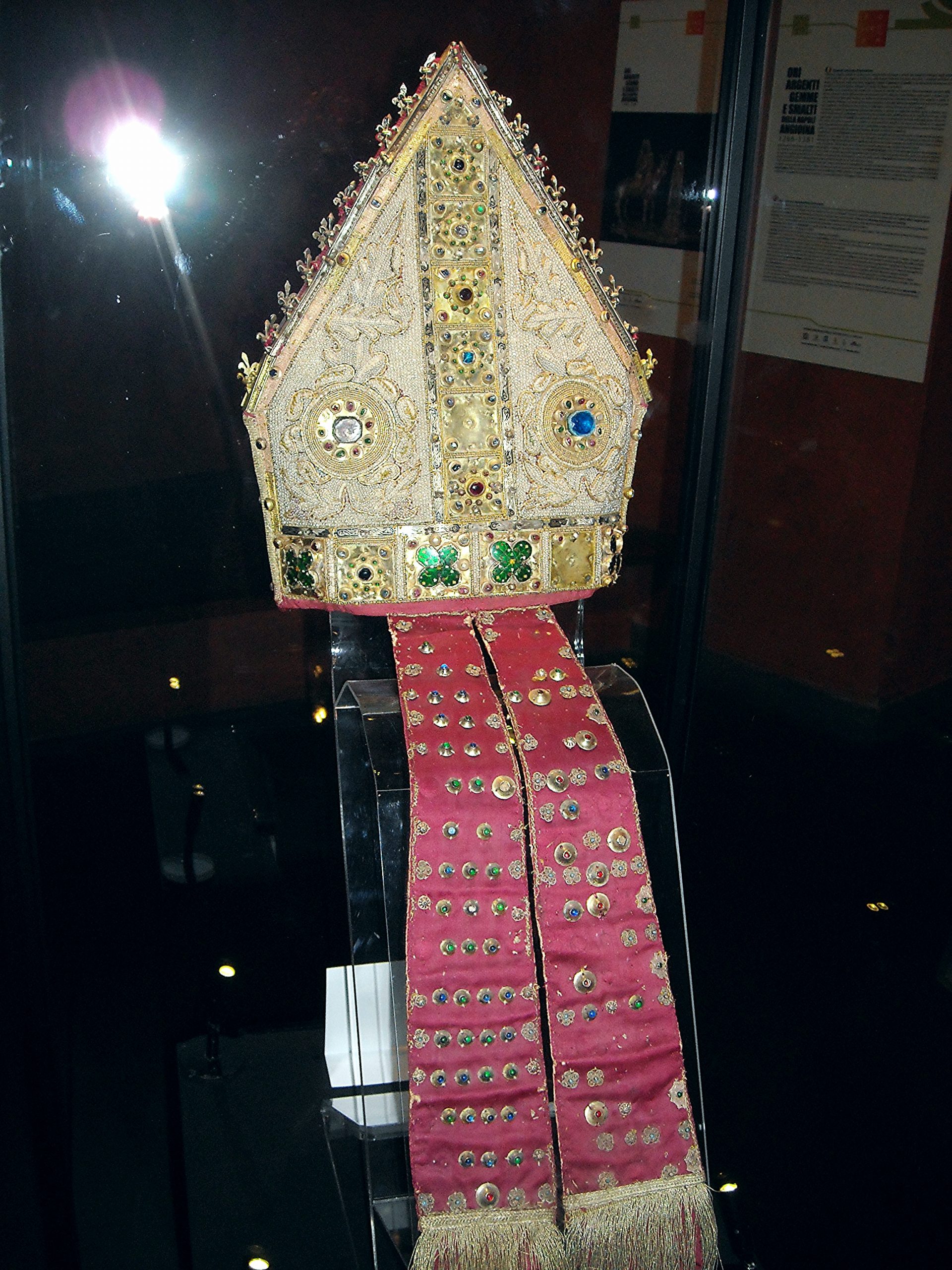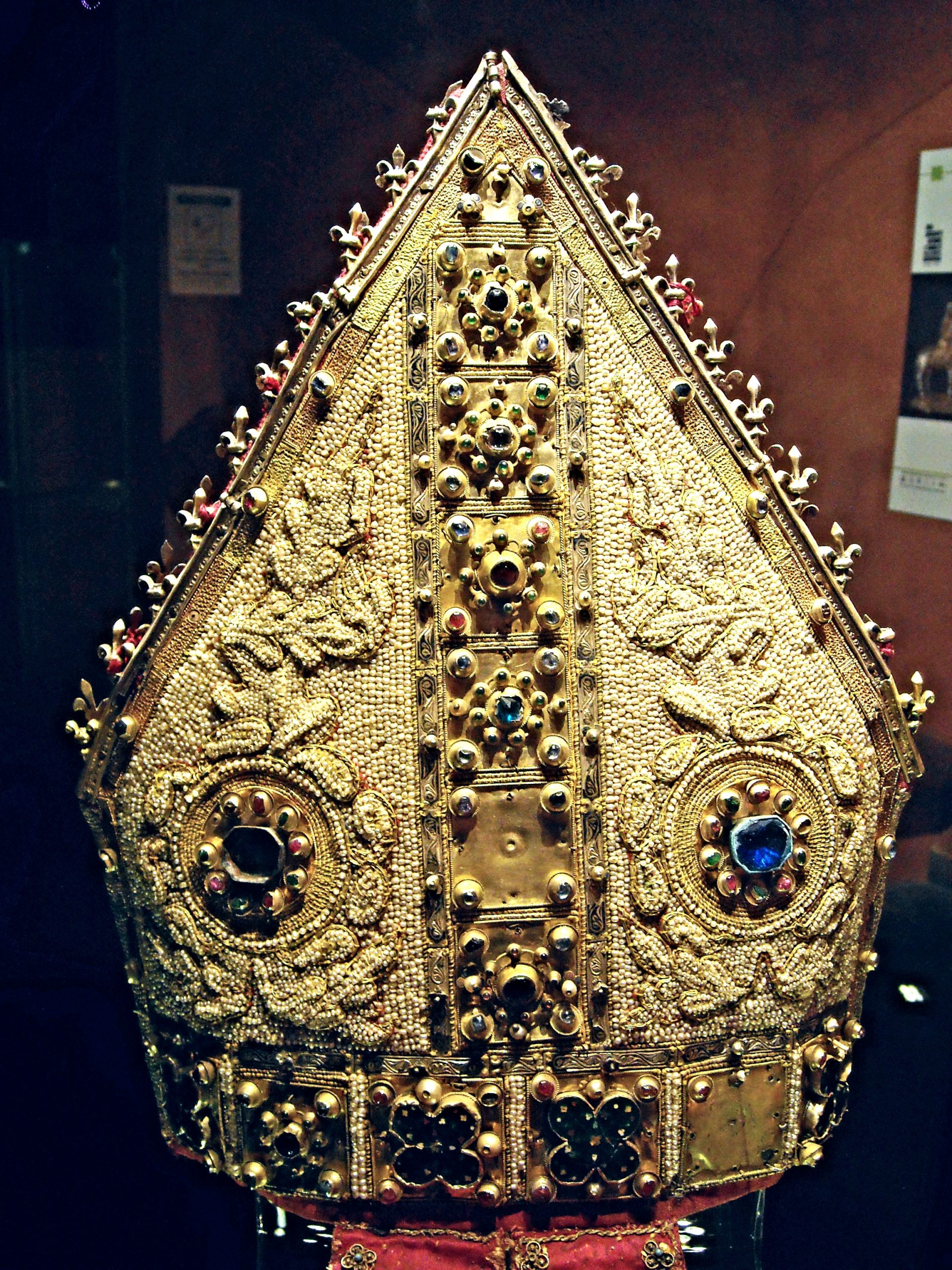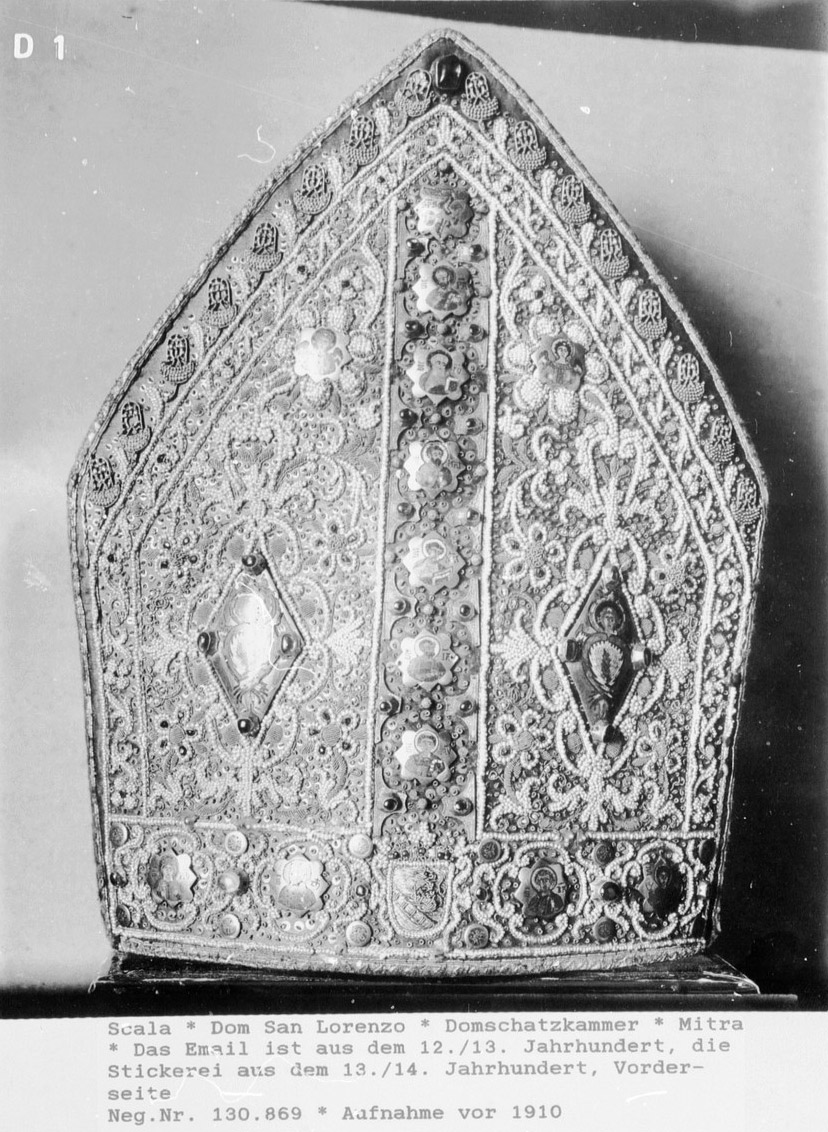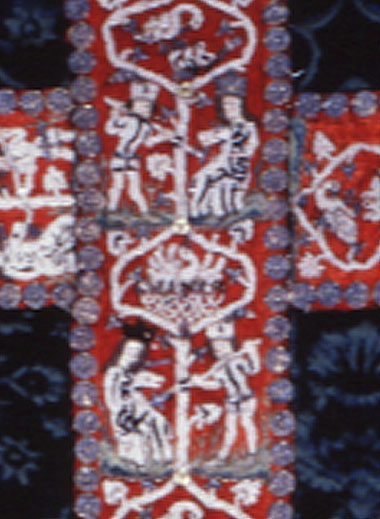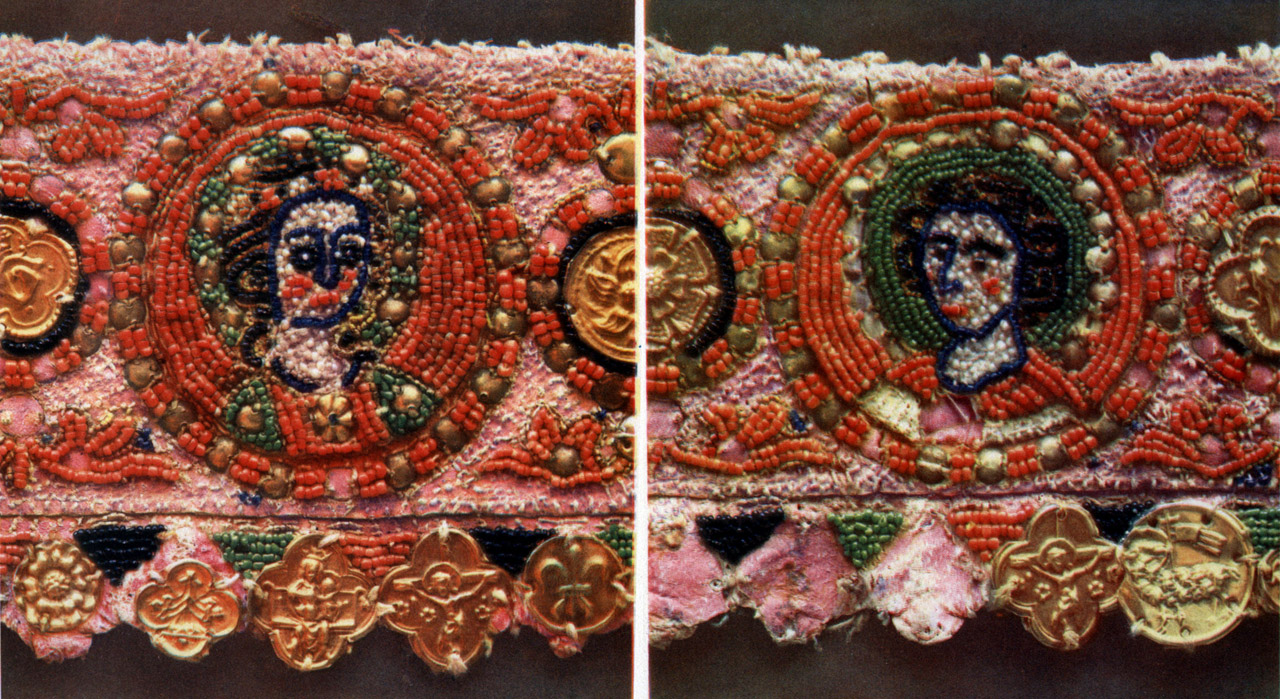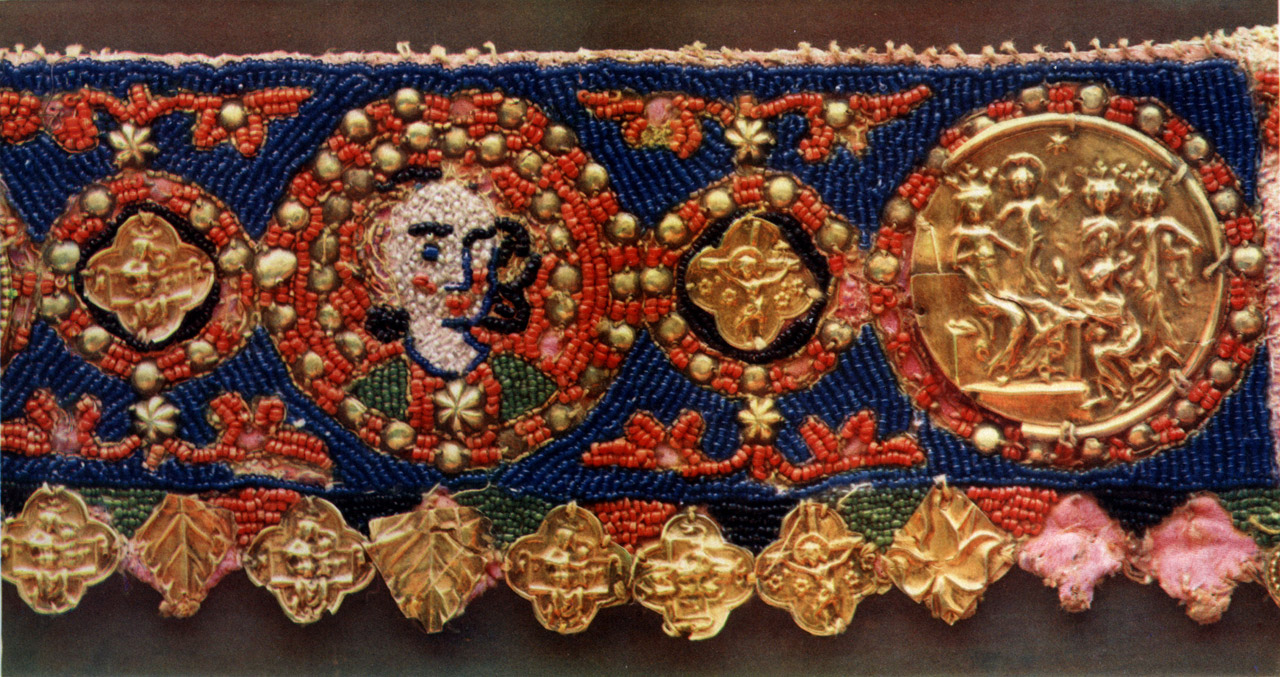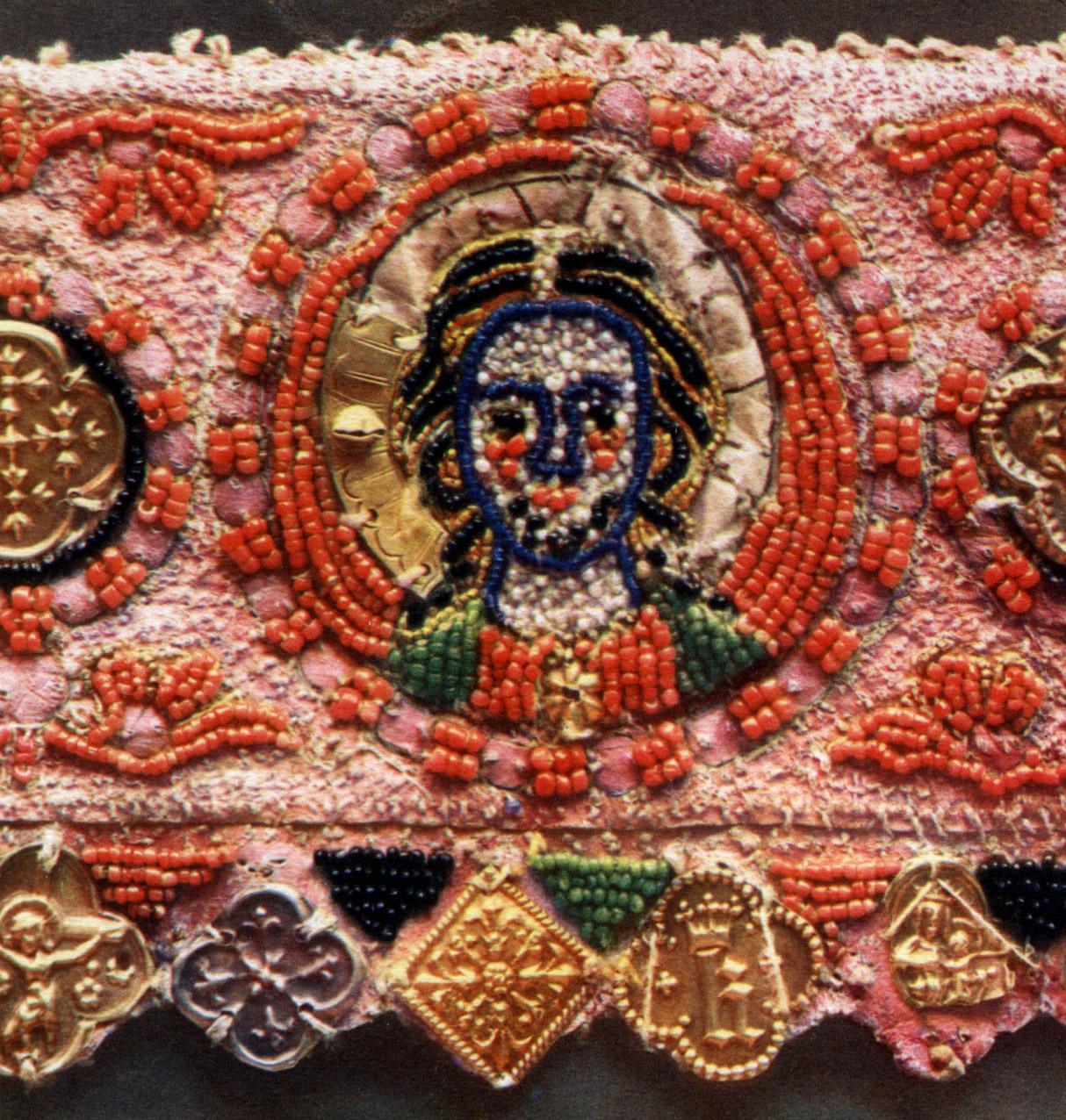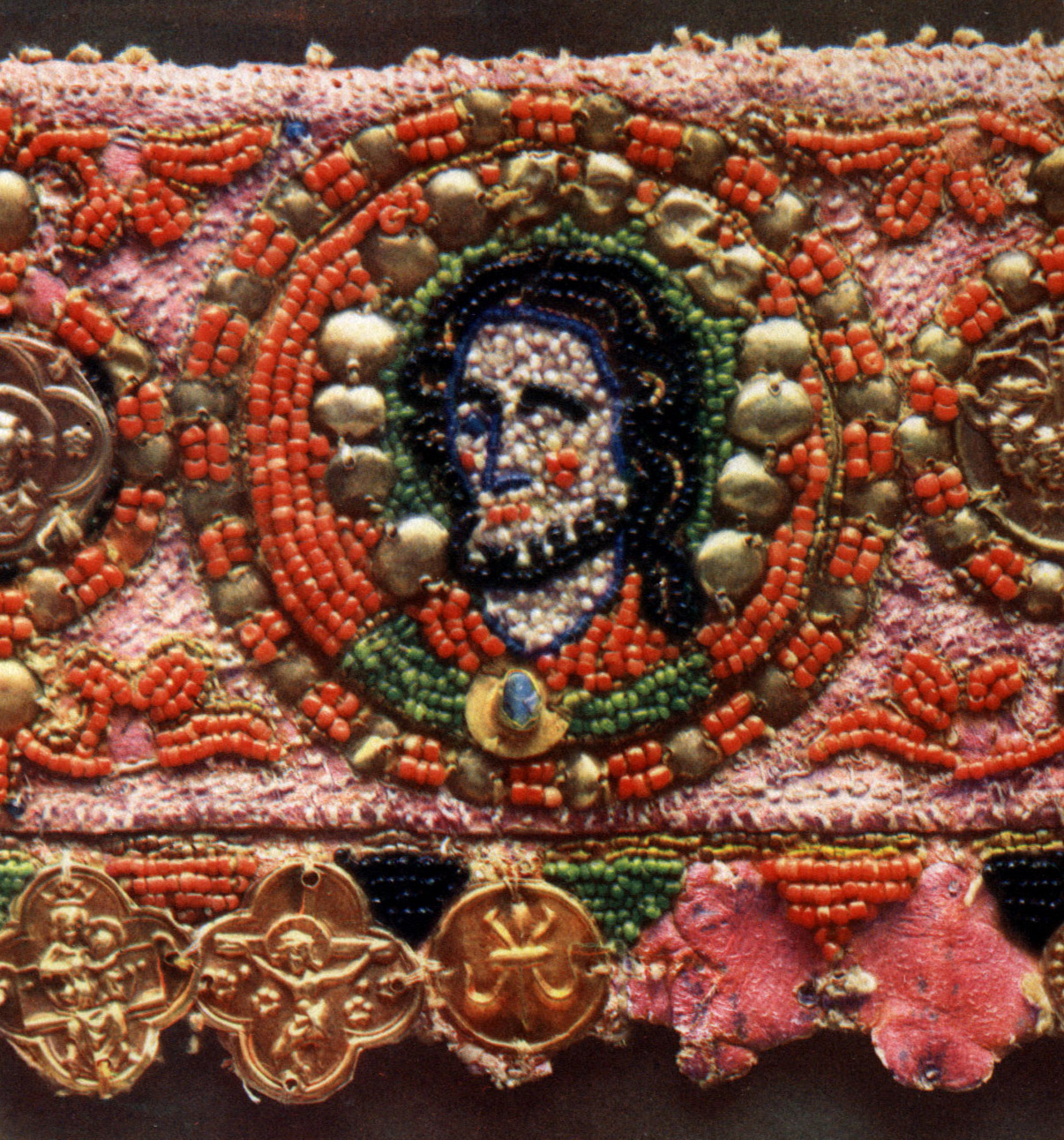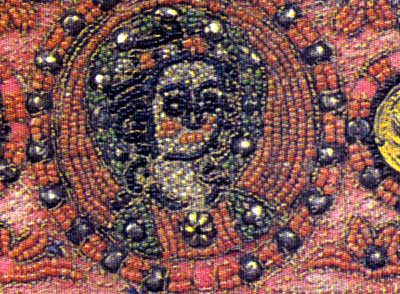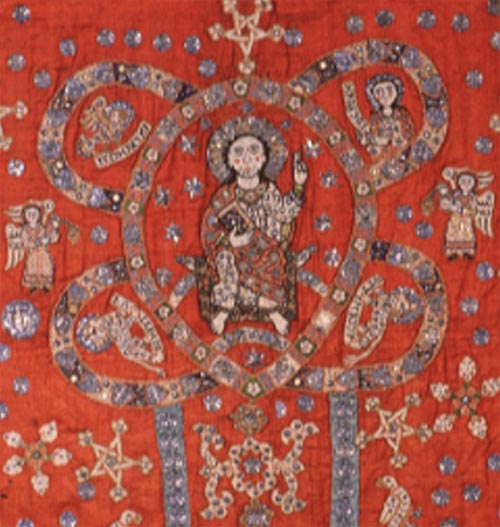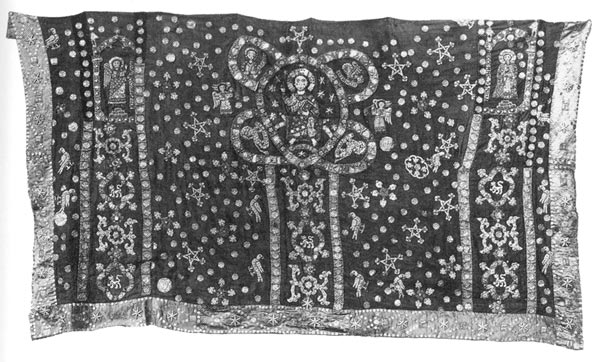
Antipendium (altar hanging) of Cathderal/Chapel of Cheb*
Approx. 1300 AD.
Okay, I freely admit I’m extremely interested in this piece since it seems to have stayed in the very cathedral/town where it was made, and lived, and is still in such great shape. I have some research on Cheb and these locations mentioned in the plate descriptions, see it after the pictures below.
Four pictures from Jessica Grimm who has this blog entry, that you must really go to as she has done a great write up on it.
*also known as Eger (see note after plate description) Dimensions: 88cm x 228cm. Museum der stadt Cheb, Czechoslovakia.
SOURCE: “La Riqueza del Bordado Eclesiastico en Checoslovaquia”, by Zoroslava Drobna, 1949
Plate info in spanish:
Antipendium bordado con abalorios multicolores (perlitas de cristal) y con coralitos rosáceos. En dos filas, una encima de la otra, que constan de diez arcadas semicirculares, tiene colocadas las figuras de la Vírgen María, de Cristo, de santos y de santas. En su parte superior consta de una tira o franja, en la cual se hallan sobrepuestas o aplicadas cabezas, pintadas y más recientes, de santos y una tira con una inscripción mulitada por restauraciones posteriores. las figuras y las arcadas han sido borodadas sobre pergamino, borado que años más tarde ha aplicado o cosido sobre una tela de seda roja. Probablemente ha sido confeccionado por las monjas del convento de Santa Clara de Cheb para la cahilla del castillo de Cheb. Proximiades del año 1300 Dimensiones 88cmx228cm Museo Municipal de Cheb.
Plate info in English – to the best of my talents and using an online translator:
Altar hanging embroidered with multicolored glass beads (glass pearls?) and with rosaceous coralitos. In two rows, one upon the other of ten semicircular arches around the figures of the Virgin Maria, Christ, saints. In the top part it consists of a border which has overlapping or applied heads, painted and more recent, of saints and a strip with an inscription mutilated by later restorations. The figures and the arches have been embroidered on parchment, embroidered over years and applied or sewn on red silk fabric. Probably was made by the nuns of the convent of Saint Klara of Cheb for chapel of the castle of Cheb. Approx. 1300 AD. Dimensions 88cm x 228cm. City Museum of Cheb, (Czechoslovakia.)
RESEARCH ON THIS PIECE’S ORIGINS
Notes About Cheb, Czech Republic: during the Middle Ages, and even into fairly modern times, Cheb (which is directly on the modern German/Czech border) has changed hands to and from Germany many times. Map of modern Czech Bohemian Province: Cheb can be seen almost extreme right, junst under the little finger section that shoots into Germany, right along the border. Youc an see how this could have changed hands many times. (another map has Cheb clearly marked extreme west point of Czech.)As a result, Germany calls it Eger and Czechoslovakia calls is Cheb.
You will see this listed more often as being from “Eger (Cheb)” more than “Cheb” alone. To make this even more confusing – There is also a Eger, Hungary It’s made my researching this piece a bit difficult, added to that all, Czechoslovakia was called “Bohemia” in period. Here is a period map of Cheb when it was Eger, Germany – the chapel of St. Klara is clearly marked in the high res pic entitled “De germania, Egrana ciuitas, olimde imperio Romanorum hodie uero regno Bohemiae subiecta”That last link calls Cheb “Located on Ohre river near the German border; town fell to Bohemian king Otakar I in 13th cen.; was often damaged by war, including in Hussite wars (1419-1436), Thirty Years’ War (1618-1648) & War of Austrian Succession (1740-1748). ”
The Czech.cz history page, mentions German Colonization inthe 13th Century. Now, Locating the piece’s orgin in Cheb (Then named “Eger”):The plate description above says this was: “Probably was made by the nuns of the convent of Saint Klara of Cheb for chapel of the castle of Cheb.” Let’s break this down.
You can see some of these Cheb locations, as they stand now that are mentioned above, at Cheb’s Wepage and the above map link which I think shows them in period as well. So does this page.
The convent was founded as a Franciscan church, and functioned as such for a couple hundred years, but converted to a Minorite (“Minores”) order in the 1500’s – which is whwen this map was made. (go about half way across) *right* next to the what we conclude to be the very Convent of St Klara (“S:Klara”) Cheb’s page even notes the order change: “Franciscan church: The Minorite church was built simultaneously with a convent after 1247 when Franciscans settled in Cheb. A vestry and adjacent portion of walling has been preserved from the original building from the mid-13th Century. A cloister of the convent from the 1st half of the 14th Century is one of the most beautiful landmarks in the town’s historical center.” So we know it was there at the right time, and we know it’s still there. Now, If you look at the modern pic of the Minorite churchand the period map of Cheb when it was Eger, Germany, you can see a definite resemblance of the modern and to the towers of “S:Klara” and the adjacent”Minores” in the map, which would be the Minorite Church.
In the 15th Century a bunch of Franciscan monasteries converted sub order called Minorite, who I thinks were a little more conservative, even more than the “Poor Clare’s” who were founded by St Clare and who’s tenants included strict cloistering away from the world and devout poverty.
We know that the the Convent of St Klara was adjacendt to the “Minorite” church from the map. We’re at the very least in the right area of town, and it’s really cool to at least see in period where it came from, if it is from where they say.
John Moorman, MEDIEVAL FRANCISCAN HOUSES, St. Bonaventure (NY): The Franciscan Institute, 1983:[page 169:] FRANCISCAN FRIARY AT “EGER (Cheb): Franciscan Province of Saxony or Bohemia, Leipzig.”Before 1256 (AFH v, 362). In 1270 the town was burnt down, including the church of the friars. Four friars and ten others were burnt to death in the church (AF ii, 83). It became Observant in due course, but the date of this is uncertain. Some say 1463 (“Beiträge Sächs. 1907, 9); others give 1465 (AFH v, 362) or 1472 (FS i, 239).”[page 582] POOR CLARES at Eger “Founded c. 1270 being built next to the friars’ convent (AFH v, 362-3). Some put the date as 1264 and say that the house was affiliated to Seusslitz (S. Chiara 438). In 1465 some sisters were sent from Nuremberg to carry out reforms (AF ii, 417-8).”Abbesses: “c. 1270: Adelheit von Lobhaus (Wauer, Entstehung 141n); 1469: Felicity Trautmann (AF ii, 418, 477); 1469 Margaret Grunther (Priorissa) AFii, 418, 477)”
And who was it made for?
It says in the plate description… ” …for chapel of the castle of Cheb” (again, it was Eger)Cheb’s page shows them too. Here’s the castle and here’s the castle’s chapel interior (and A detail picture). Here’s a modern Map of Cheb , you an see the castle (#4) up in the the northern bend of the river.
#8 is the convent.
#3 is where the piece lives now, the Musem of Cheb.
The Beads: Where did they come from?
Cheb is located less than 40 Kilometers from the small bavarian town of Bischofsgrun, Germany, which is just a few miles on the other side of the modern Czech/German Border.Bischofsgrun is important in many ways. It is one of the first glassmaking capitols in that part of Europe. A “glass hut” (translation from web) was found dating from 900. “Bischofesgrune” was first mentioned in 1242. The tradition of glass-making was first mentioned in 1340 (*1). by 1536 they had 39 glass houses (*2). Duke Albrecht V requested the court cartographer to a map of Bavaria in 1554-1561. In it he included the desctiption as: “Here there are many Glassworks, (producing) blown glass, exceptional mirror glass, and glass beads.” (*3). Modernly Bischofsgrun is famed for it’s history as a medieval stained glass center, and is part of many “glass tours” for those who study glass history. I think it’s a good possibility the beads may have come from Bischofsgrun, or even perhaps there was an even closer factory. Glass makers were considered a reputable and desirable industry.
(*1).source: Bischofsgrun, Germany glass tour website
(*2) source: Bischofsgrun, Germany website
(*3) source: Sibyll Jorgstaff, Glass Beads Of EuropeNEW Text about Cheb History: Following text from this page on Cheb:
The history of Cheb, one of Bohemia’s oldest towns, dates from the 9th century. The remains of a Slavonic settlement have been found on the site of todays castle, in its strategic location above the Ohre river. The first reference to Cheb was in a document by Germany king Heinrich IV., in 1061. The town was then called Egre, derived from “Agara”, the Celtic name of the river running through it and taken into German as “Eger”. The Czech name goes back at least to 1322. During the 12th century, Cheb came under the administration of the margraves of Vohburg and German colonization followed. In 1149, Cheb came under the House of Hohenstauf. Friedrich Barbarossa, the emperor and the most significant member of the family, made Cheb a stronghold of his power politics aimed against the Principality of Bohemia. Czech rulers, however, also proved interested in the regions strategic location. Using the claim to inheritance as a pretext, Premysl Otakar II invaded the once Slavonic territory in 1266 and temporarily annexed it to Bohemia. Until 1305 the region was administered by Vaclav II, Otakars son, who gained control over it as part of the dowry of his wife Guta, a daughter of the Emperor Rudolph of Hapsburg. Although the town was repeatedly taken by the German Empire after Vaclavs death, the inhabitants of Cheb maintained good relations with Bohemia and, after the Premyslid dynasty, became growingly concerned about stability. The permanent annexation of Cheb to the Bohemian Crown Lands came in 1322. John of Luxembourg, the Czech king, acquired the region from Ludwig the Bavarian as a hereditary pledge in recognition of service in the fight for the Emperors throne.
In the 14th century, Cheb was one of the leading towns in the kingdom, being the fourth biggest in Bohemia with a population of 7300. It received many privileges: the Golden Bull made Cheb inhabitants free of duties and tolls throughout the Empire, they had a provincial parliament, a provincial high court, and the minting right (1235). An important trade route, the Via Regia, led through town. During the Hussite wars, the town sided with Catholics and was the point of departure for the 1421 and 1427 crusades. History records the diplomatic negotiations of the Basel Ecclesiastic Council and the Hussites over the conditions of the latters attendance. Chebs faith in Jiri of Podebrady, the “Hussite” king, was confirmed not only by this many visits but also by his childrens weddings taking place in the town.
During the Thirty Years War, Cheb suffered attacks by Swedish, Saxon and imperial troops. The town went down in European history on the bloodstained date of 25 February 1634, when Albrecht of Wallenstein, the Emperors high commander, died at the hands of the Irish captain Deveroux.
Because of the war and the general decline of towns, the economy became stagnant. By a 1652 decree issued by Ferdinand III, Cheb was converted into a military fortress. When completed in 1740, however, the mighty Baroque structure was outdated and challenge to French troops laying siege two years later. An imperial contract brought leading Baroque architects to Cheb: K.Dienzenhofer, P.Bayer, G.Alliprandi, A.Pfeffer and others. Thanks to them the town boasts some marvelous buildings, e.g. St Clares Church, the Dominican monastery, the town hall, etc. The towns appearance was dramatically changed by the early 19th century. The fortifications were pulled down and a large part of the original Gothic town wall together with the gates was demolished. And still another event, deprived Cheb of its medieval features: the great fire of 1809. It destroyed more than 100 houses. Chebs oldest church, St John the Baptist, included.
Industrial development brought revival, in both economy and culture. In 1938, came the Munich agreement, followed by World War II. The ultimate displacement of German residents, eventually depopulated Chebs historical center, accelerating a catastrophic decay of monuments. Only resolute refurbishment put an end to such dilapidation (1956-1969). Since 1989 Cheb has become a notable culture and bussines center. International activities, like Euroregio Egrensis, have restored the tradition, and the unique character of the region.
 14th Century: silk brakteats hanging
14th Century: silk brakteats hanging
 15th Century: altar border with seed beads and brakteats
15th Century: altar border with seed beads and brakteats
 14th Century: Borders with brakteats and plaques
14th Century: Borders with brakteats and plaques
 14th Century?: border with bratkeats
14th Century?: border with bratkeats
 14th Century: Christ child cloak
14th Century: Christ child cloak
 14th Century: Christ child cloak
14th Century: Christ child cloak
 14th Century: Christ child cloak
14th Century: Christ child cloak
 14th Century: Christ child cloak
14th Century: Christ child cloak
 14th Century: brakteats
14th Century: brakteats
 14th Century: Altar Edging
14th Century: Altar Edging
 14th Century: Crist child cloak
14th Century: Crist child cloak
 14th Century: Christ child cloak
14th Century: Christ child cloak
 14th Century: Marienmantelchen
14th Century: Marienmantelchen
 14th Century: Marienwerder Antependium
14th Century: Marienwerder Antependium
 14th Century: Cheb Antependium
14th Century: Cheb Antependium

 Need to find info.
Need to find info.
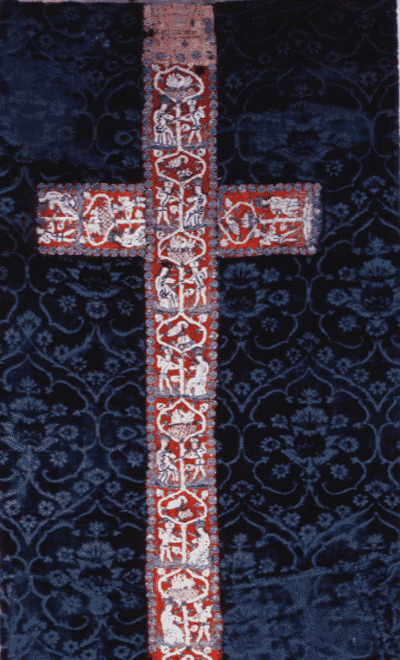







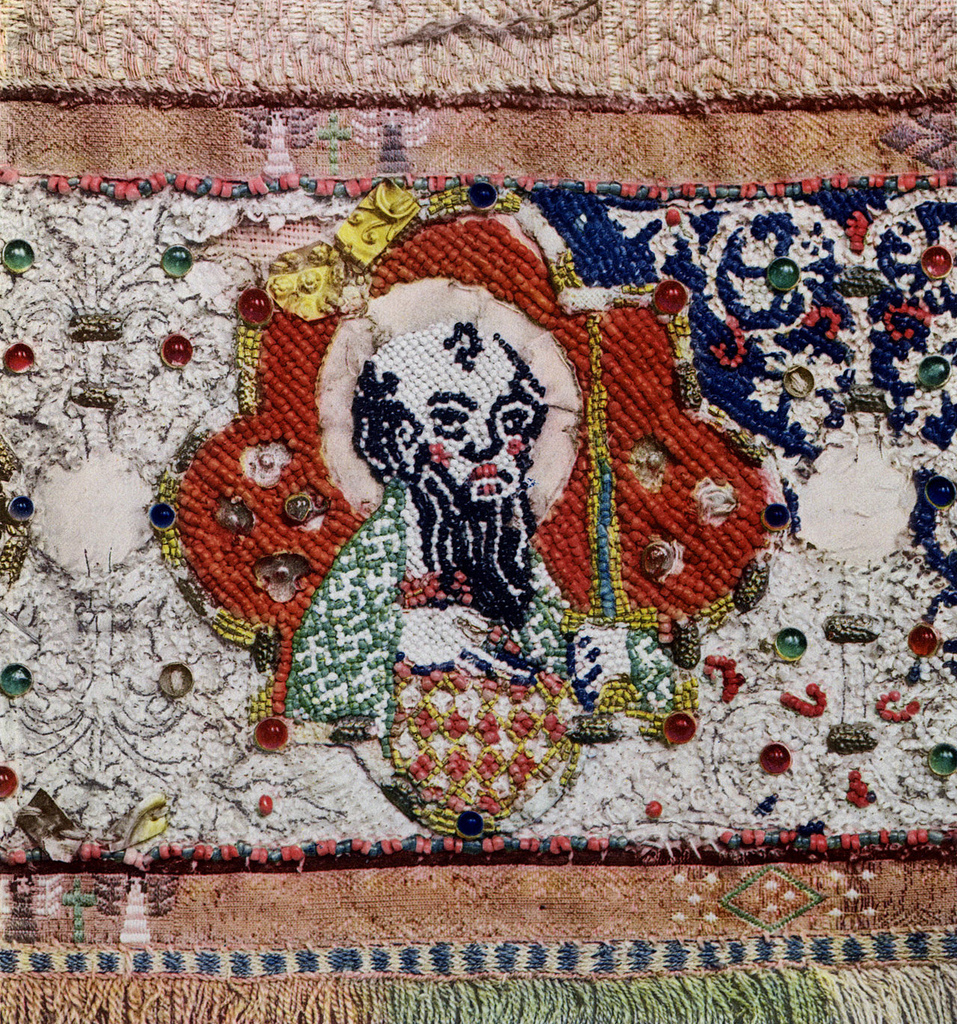














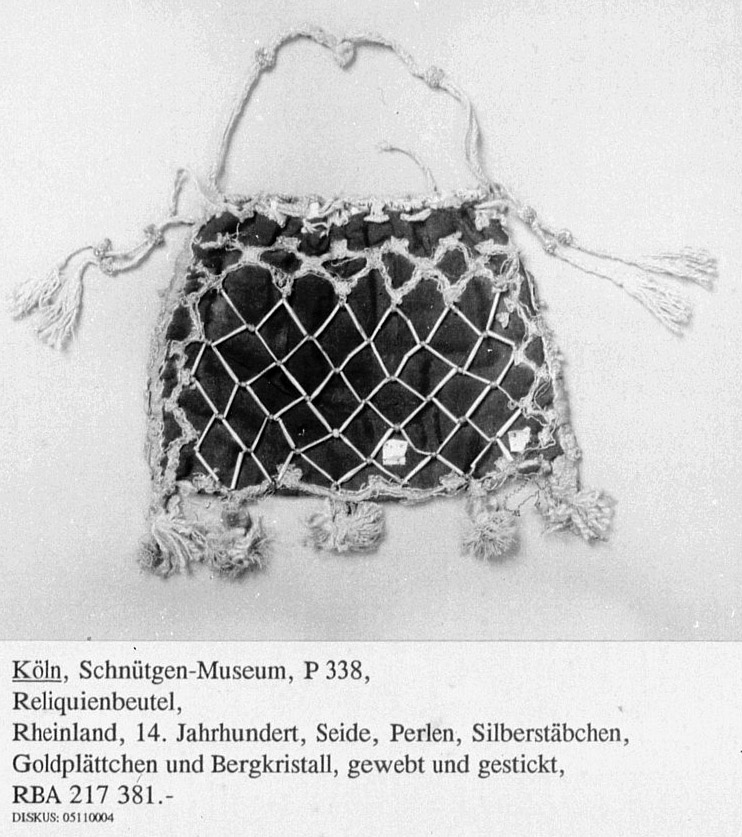





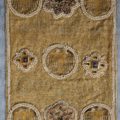










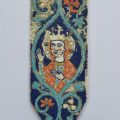






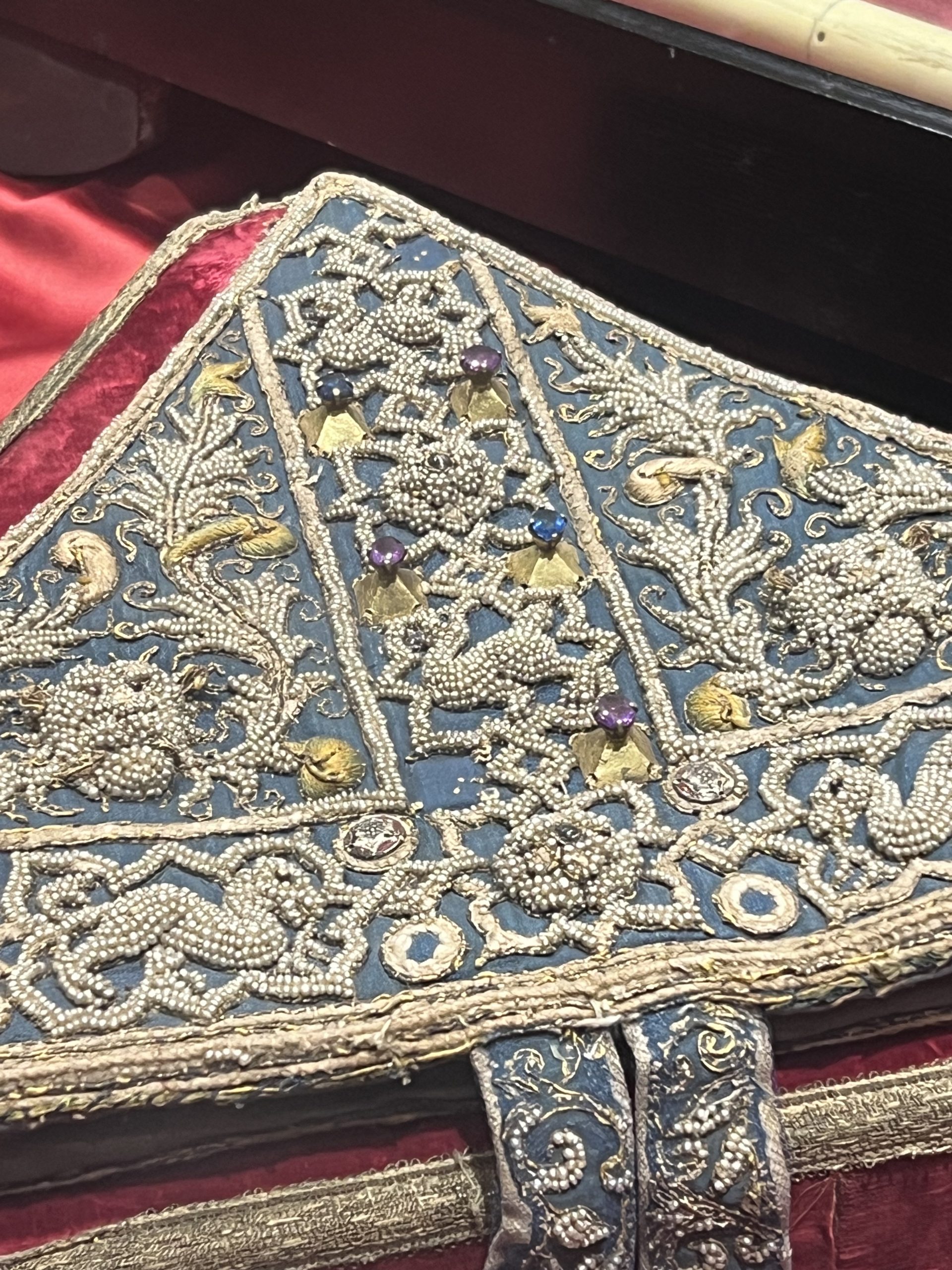


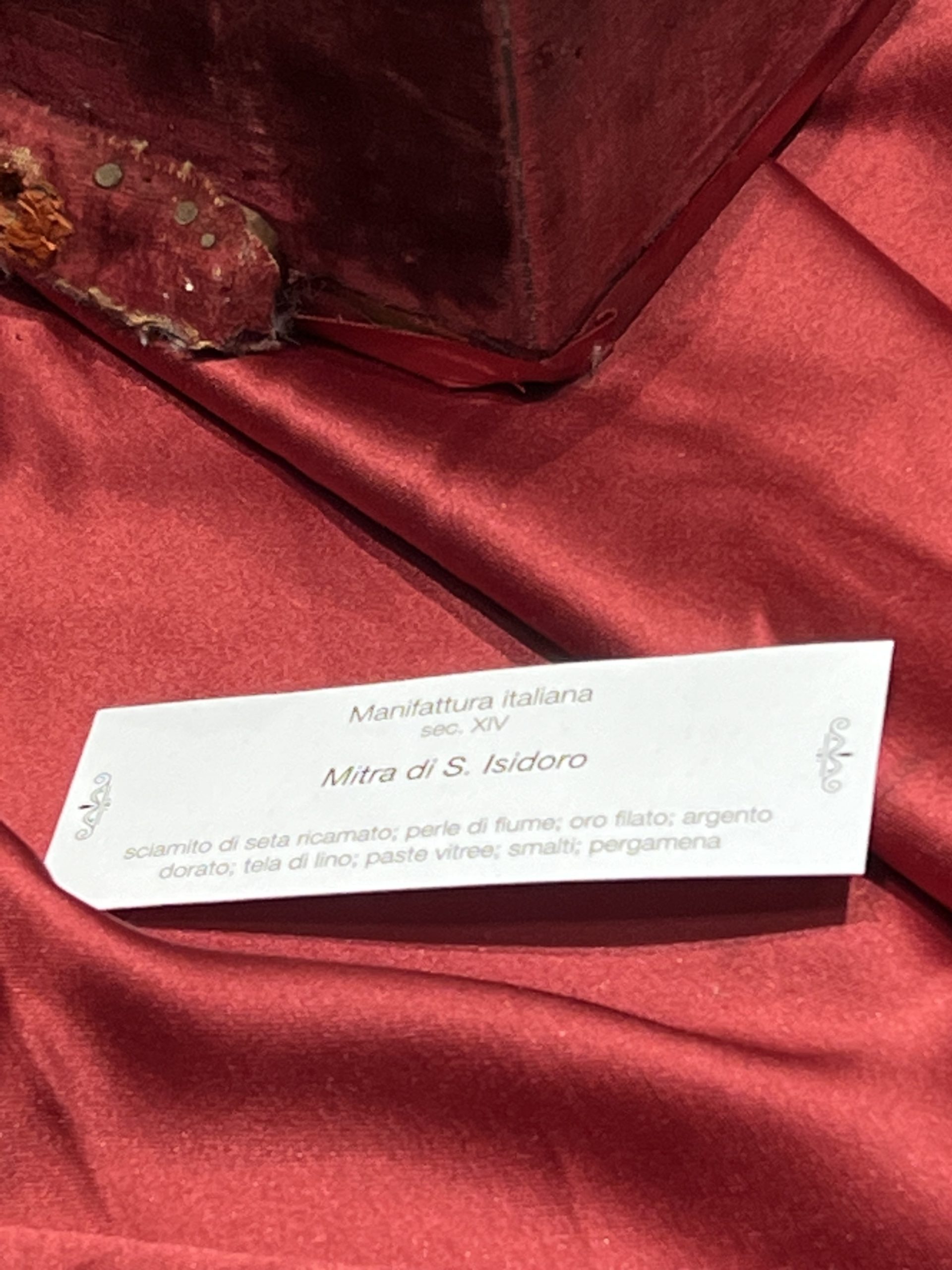

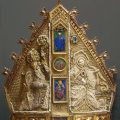







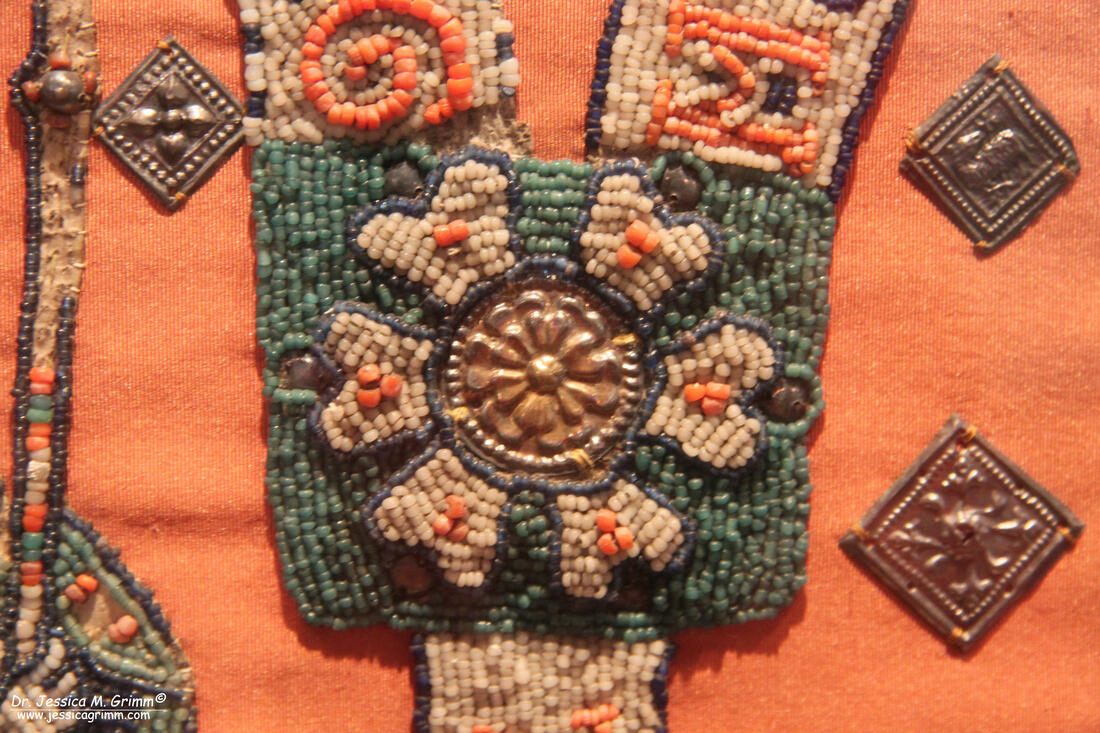




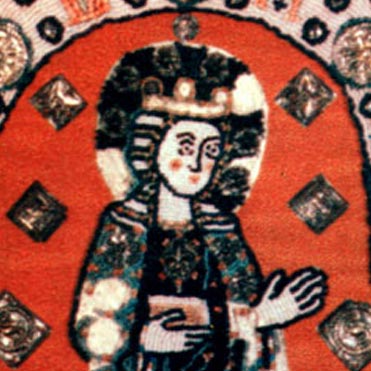
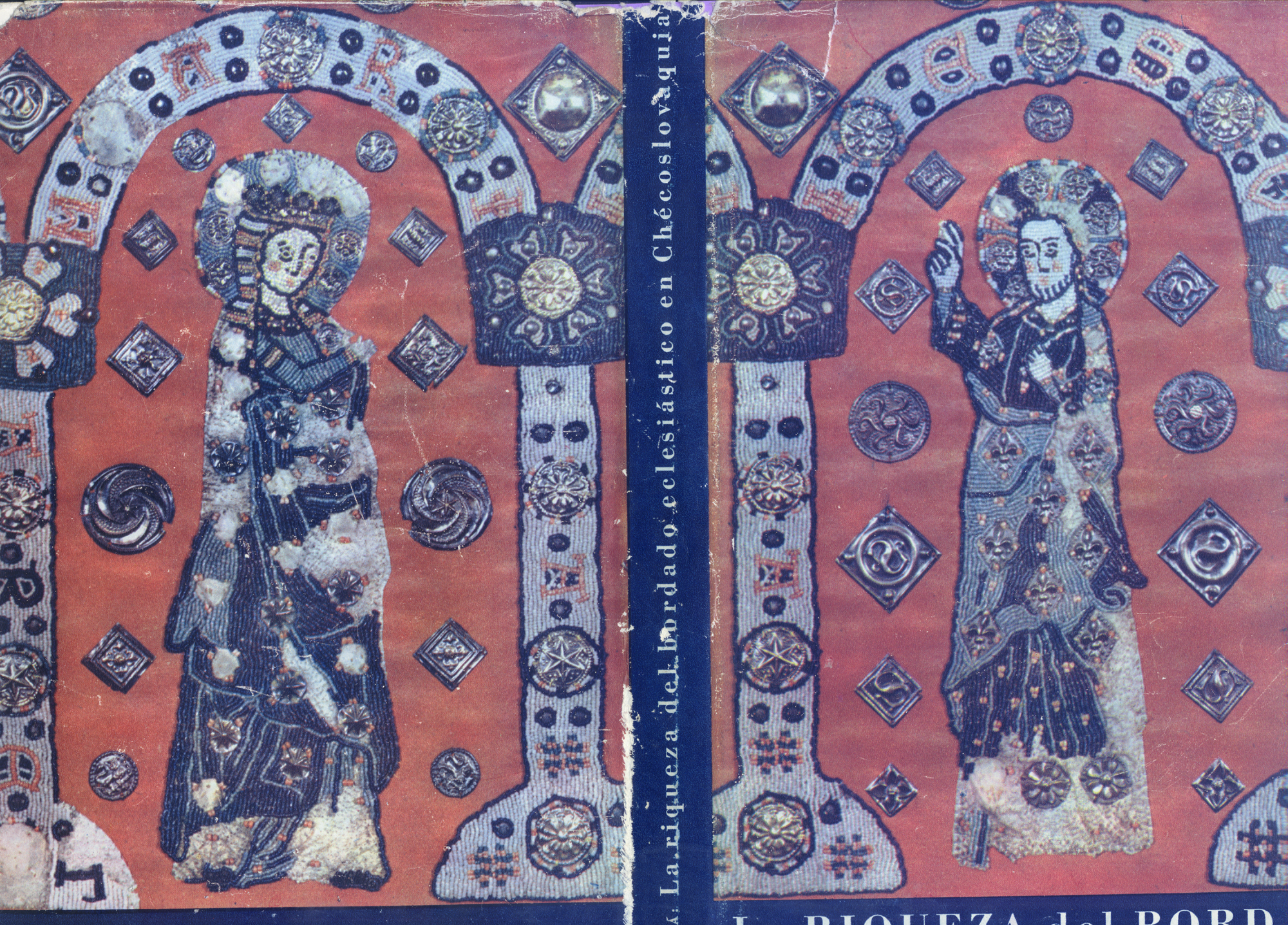




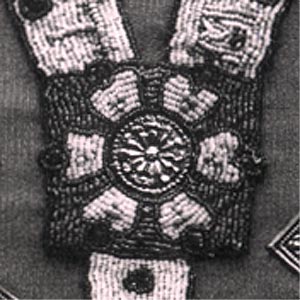
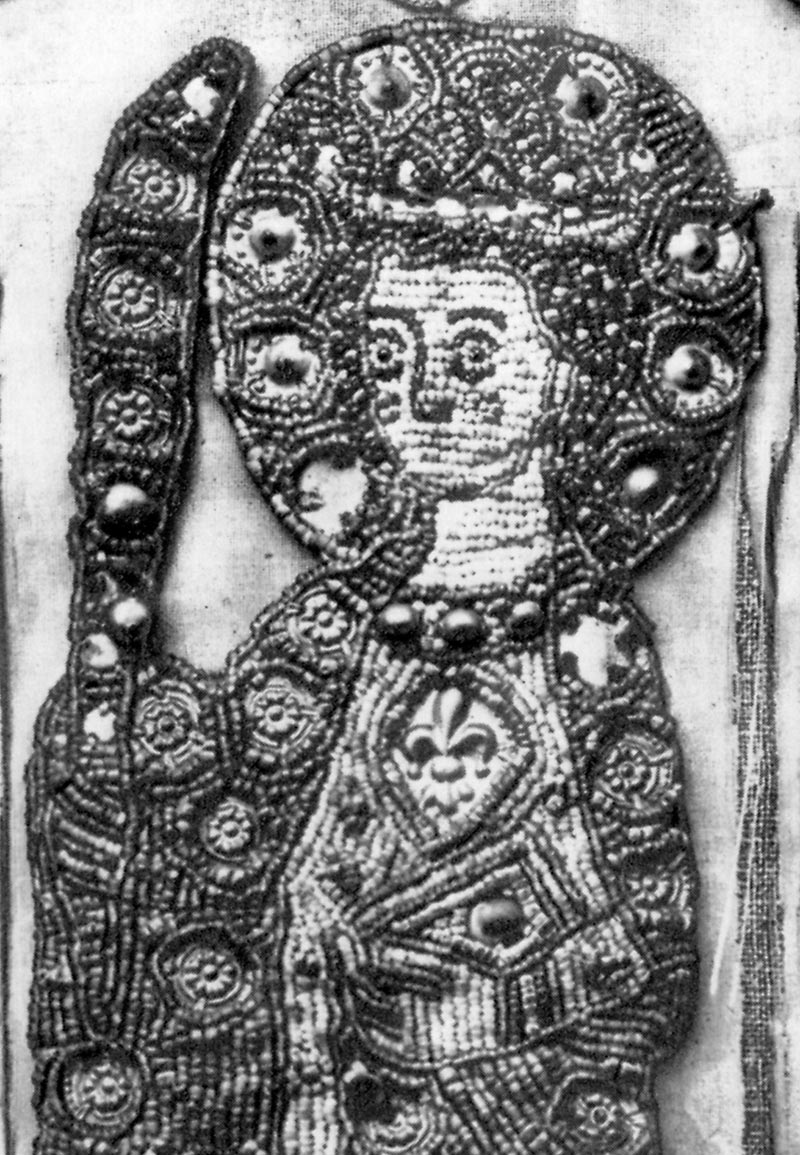

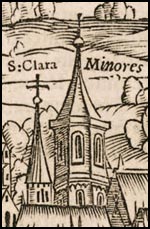
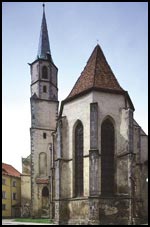








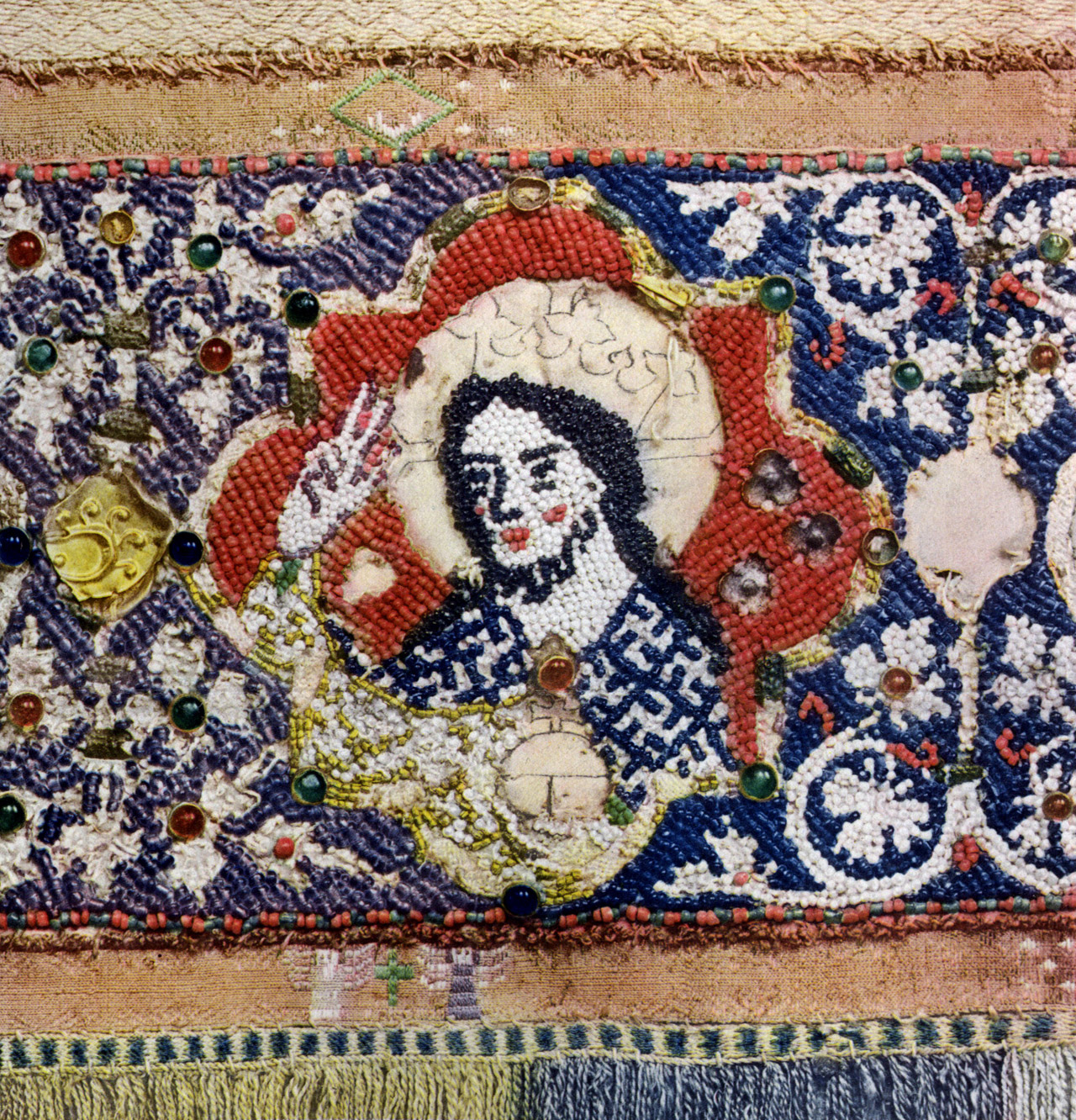
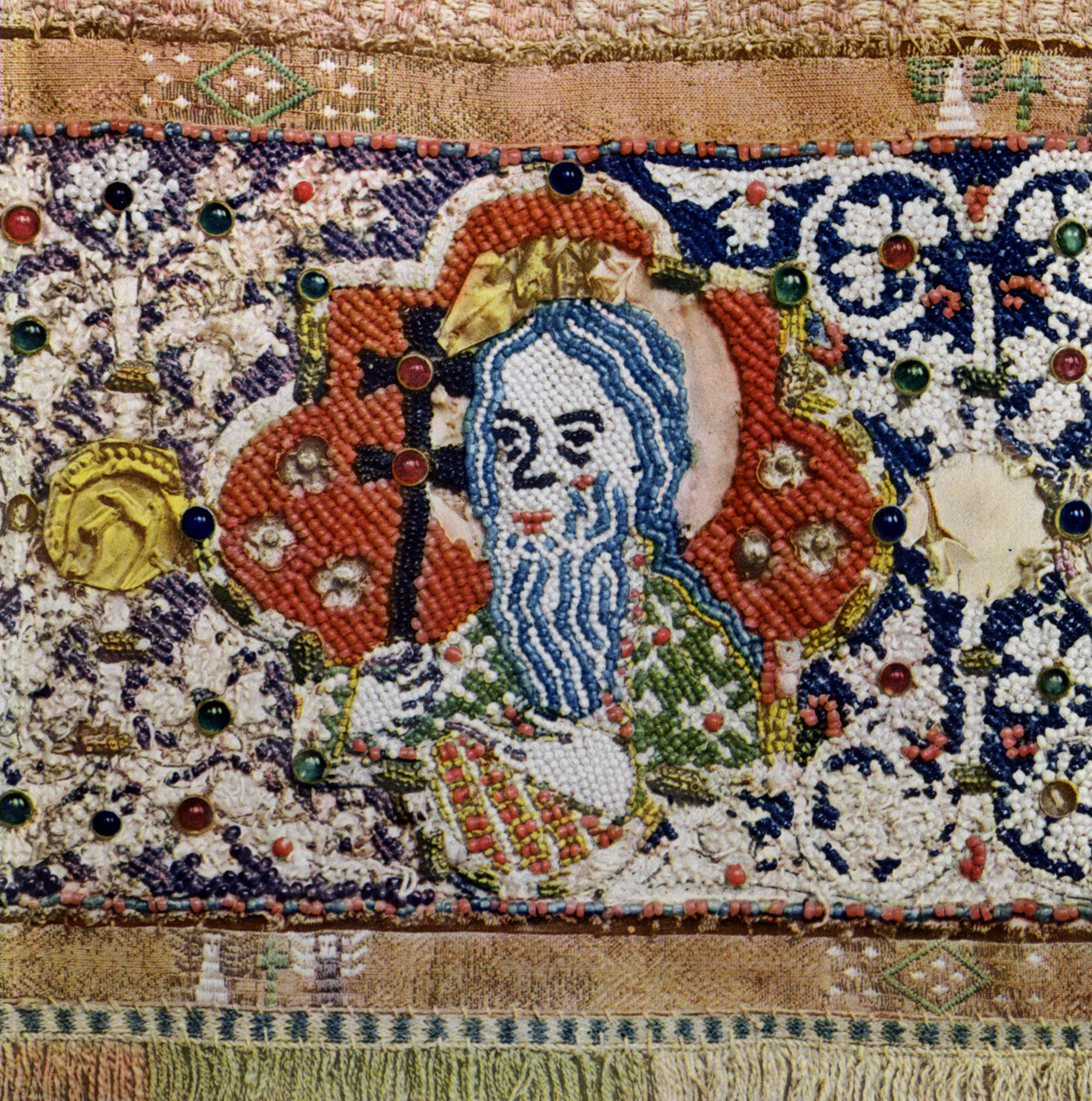

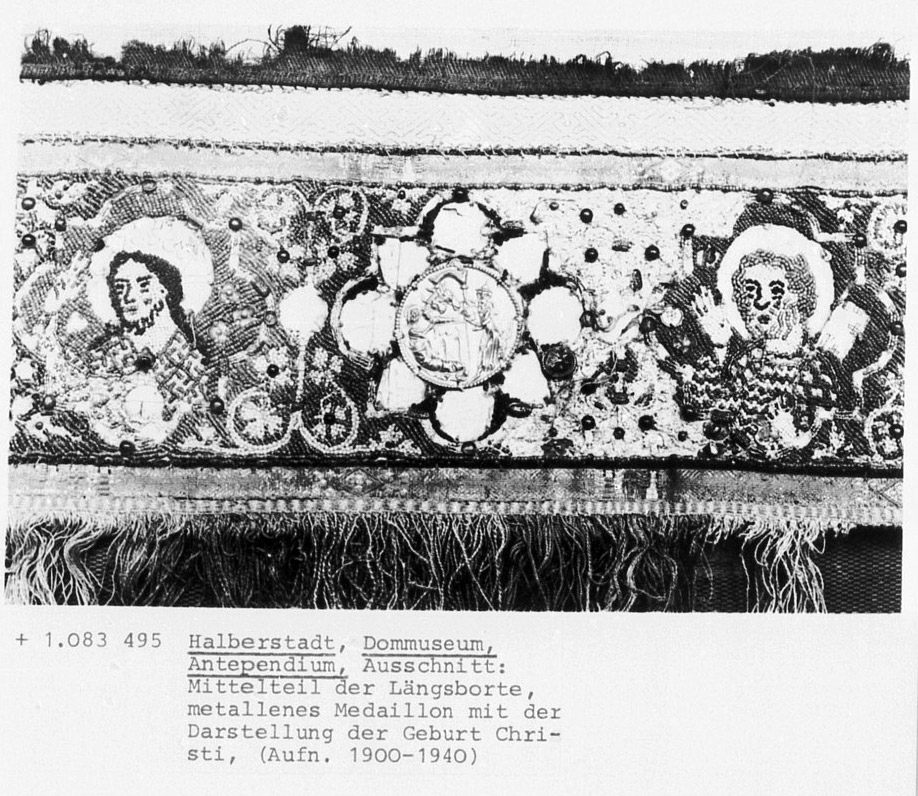
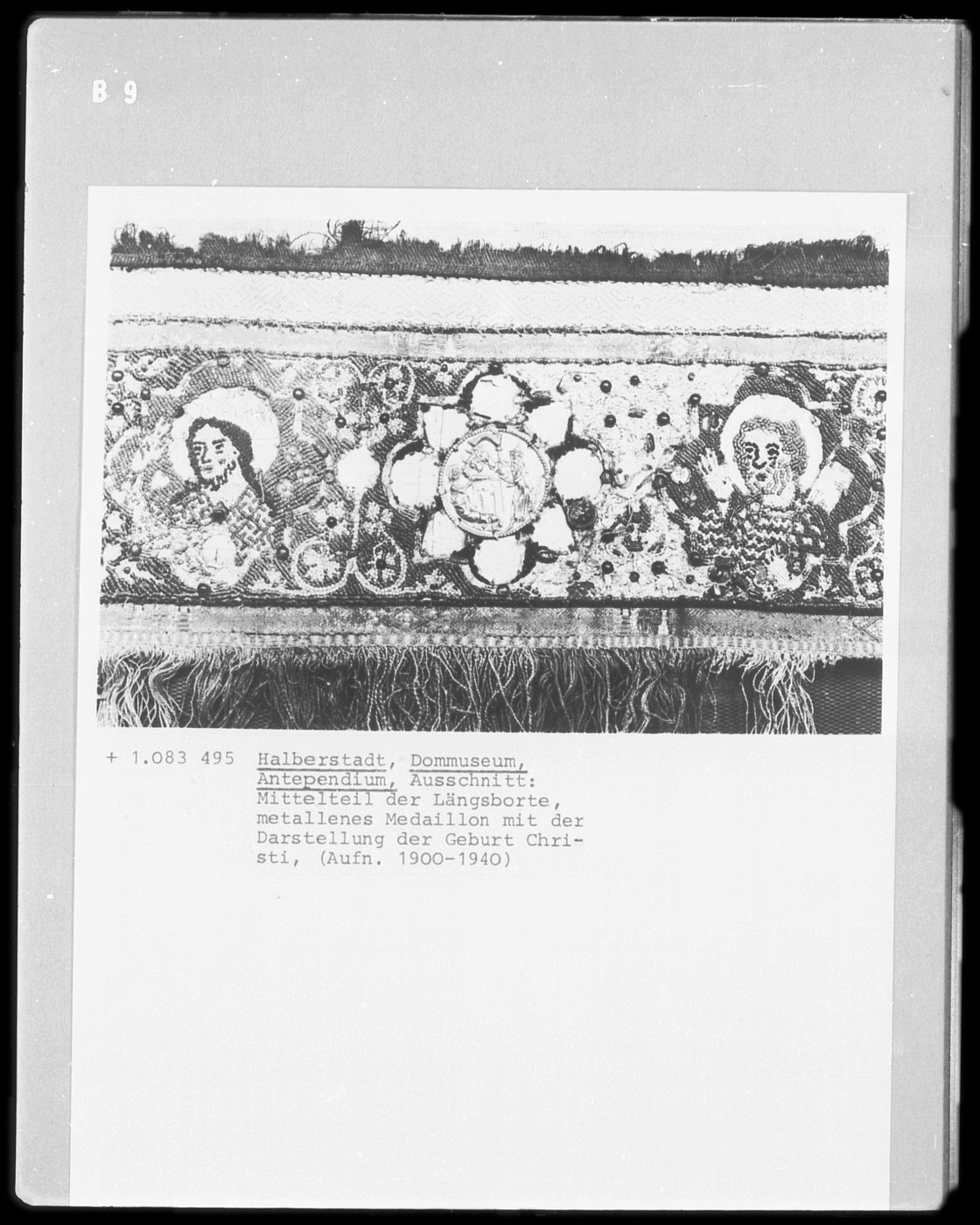
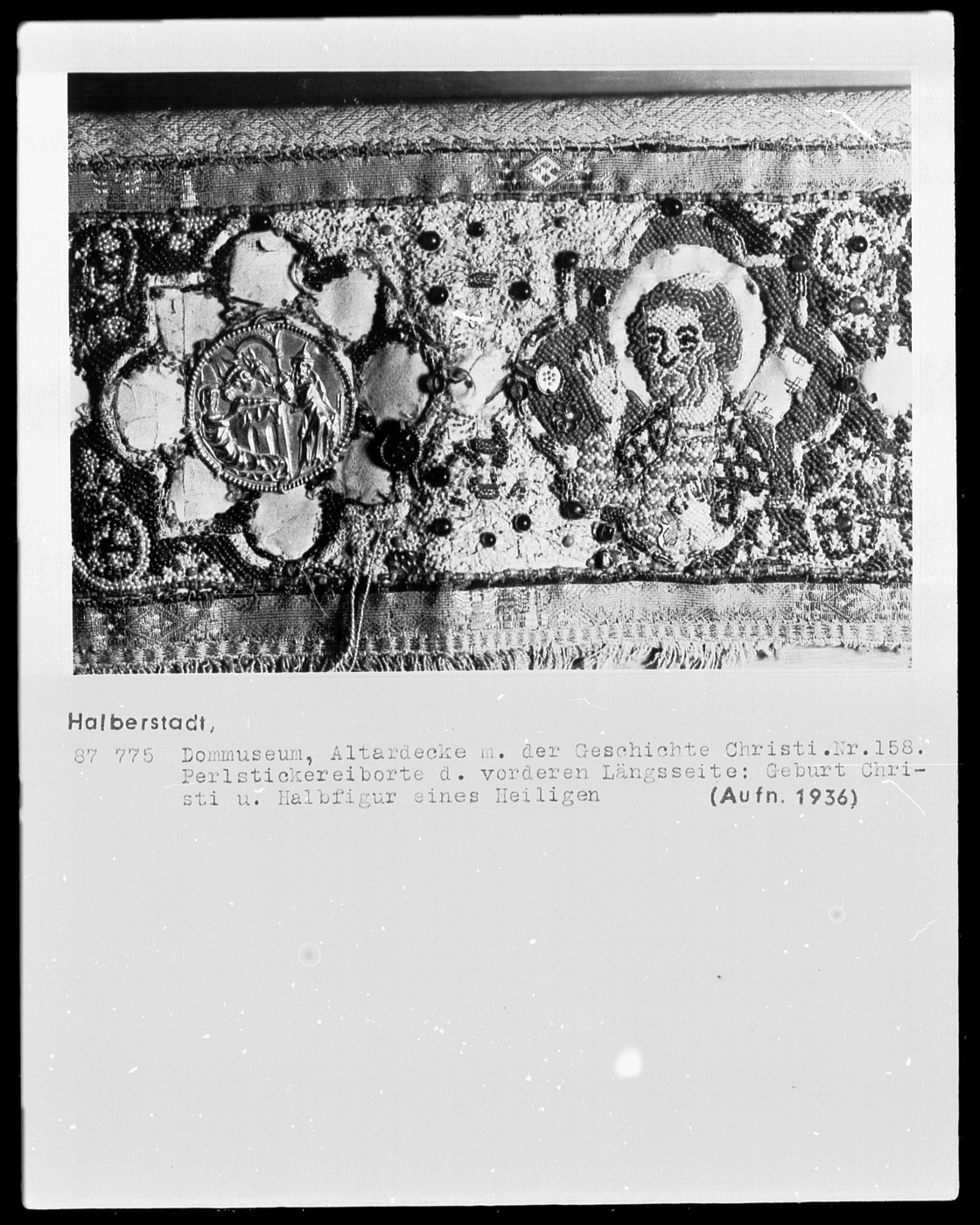



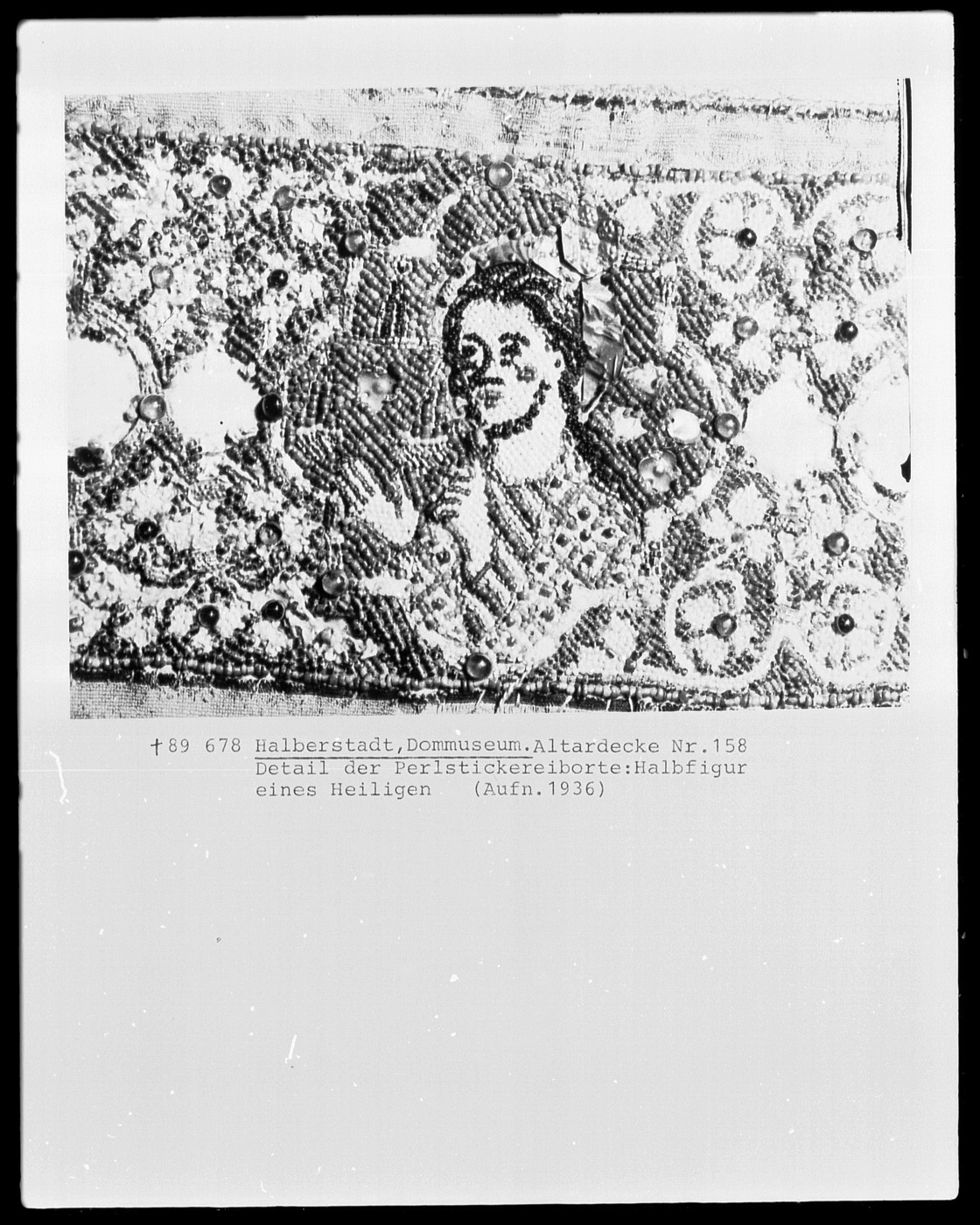
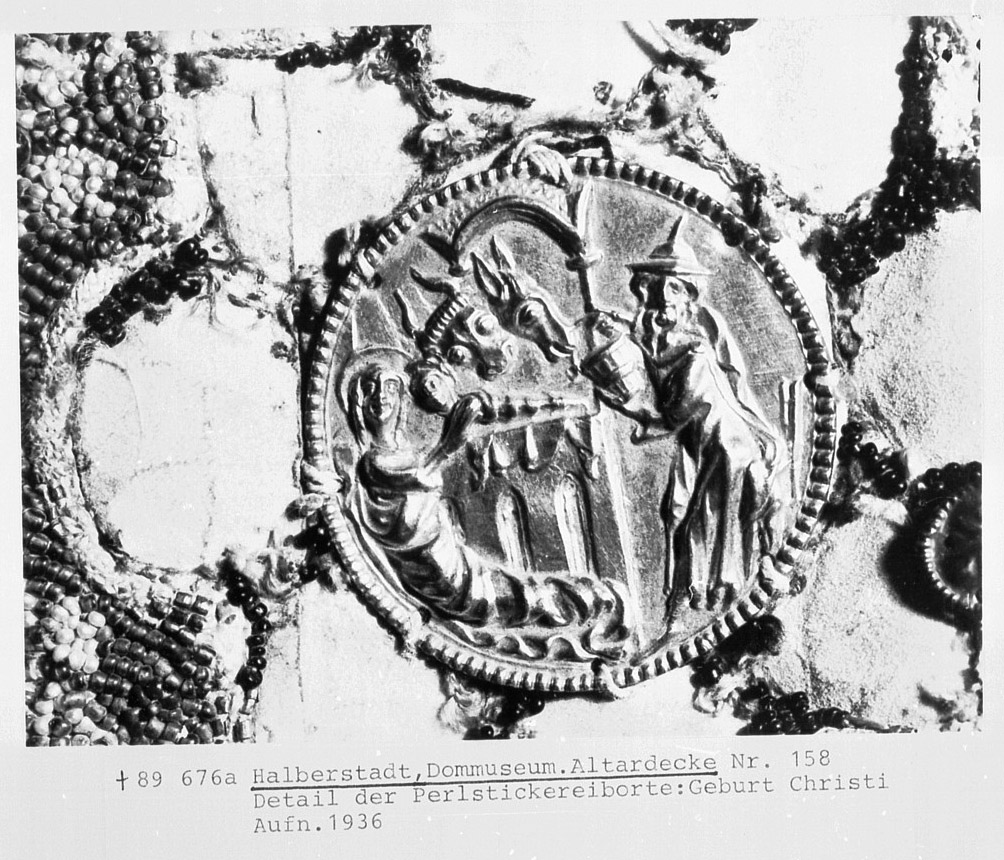
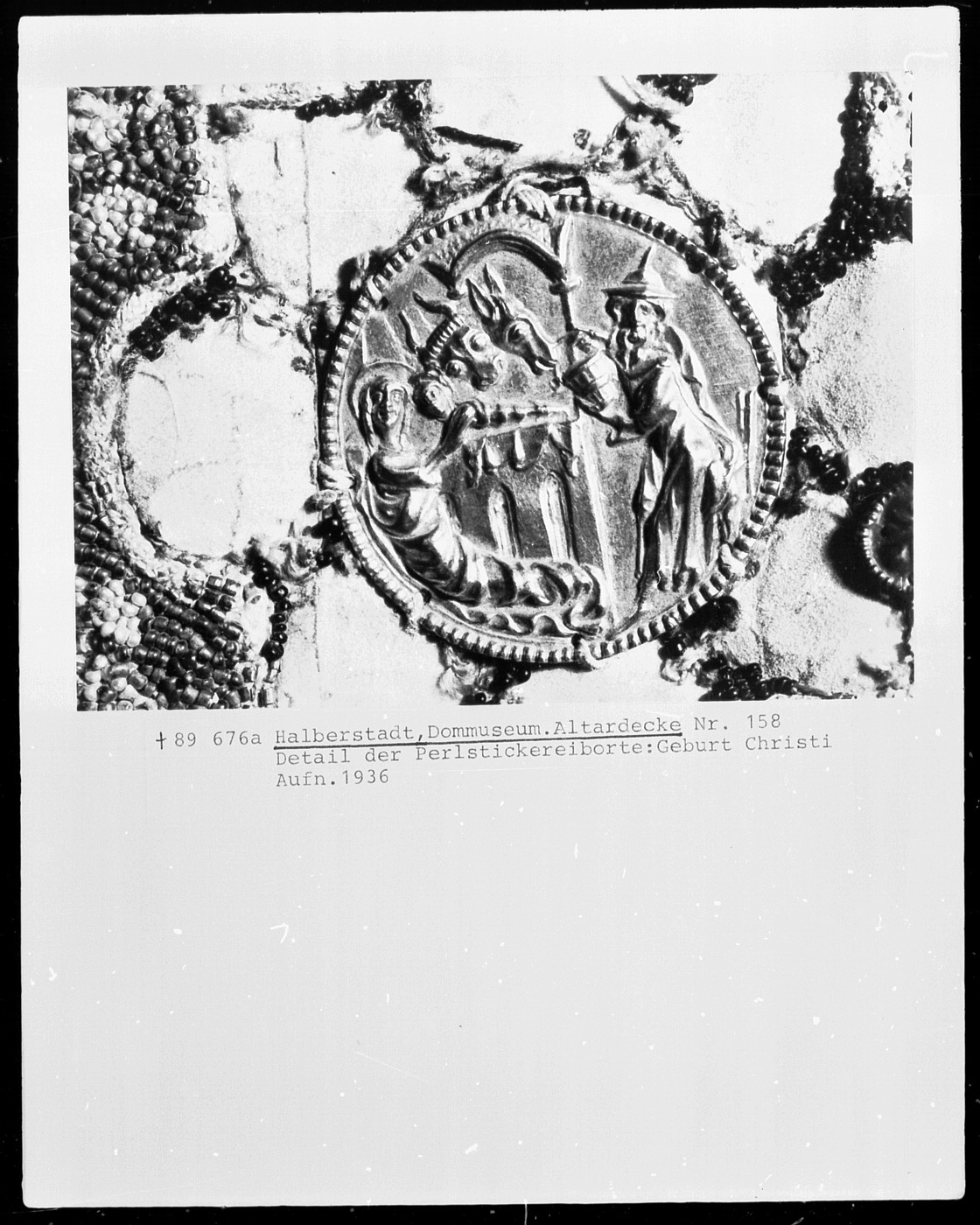

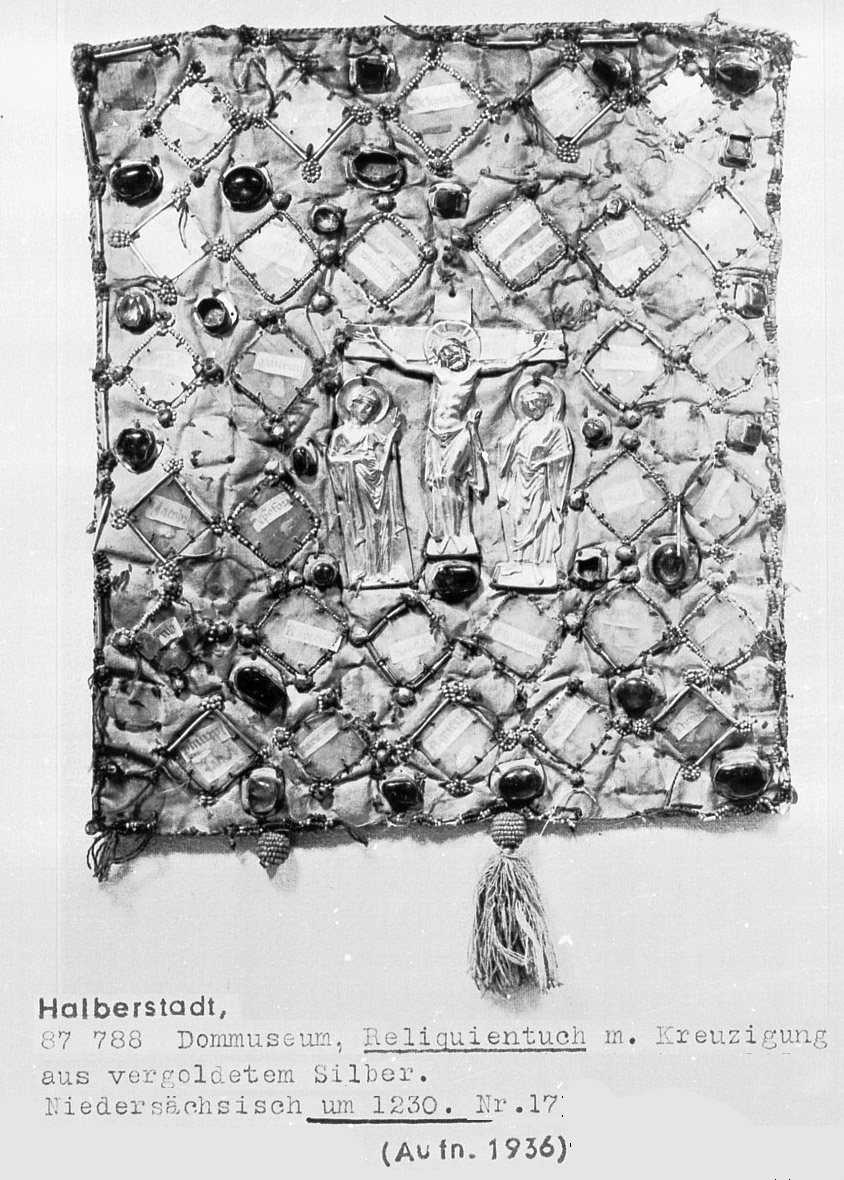

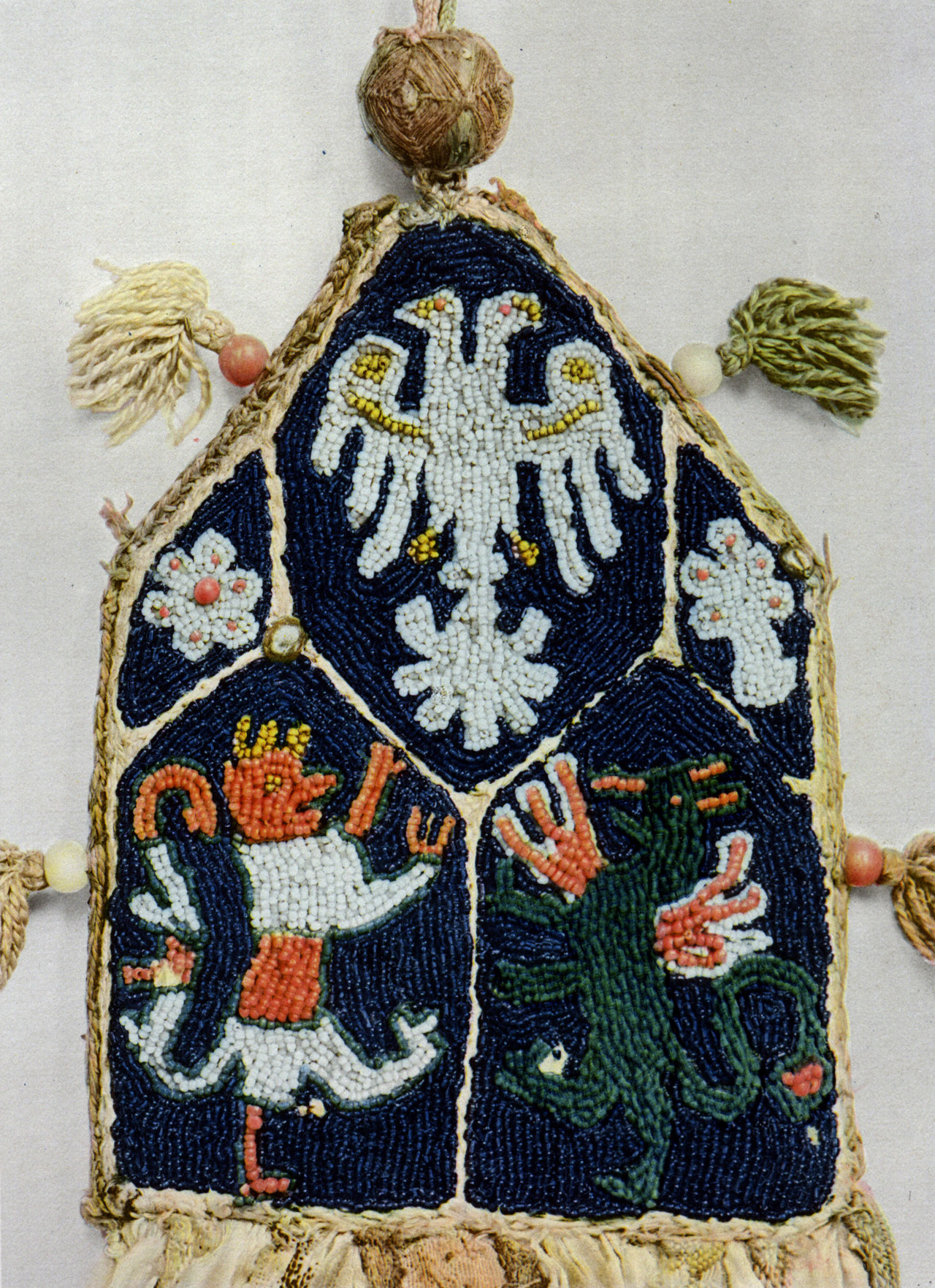







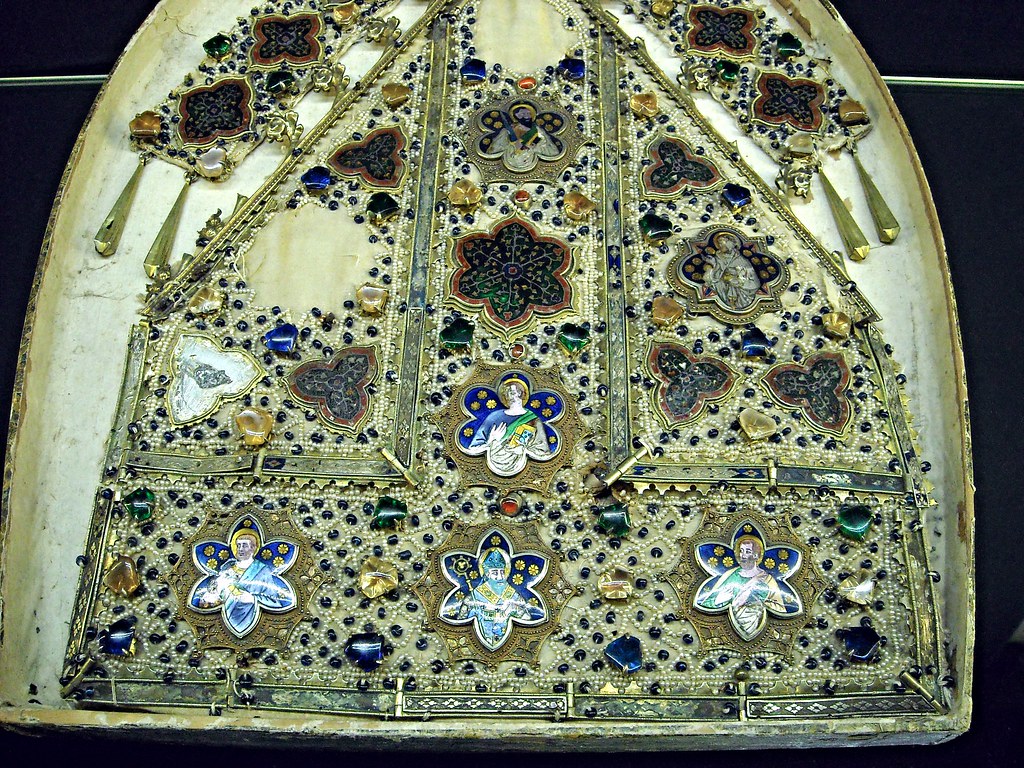



 Mitre – Amalfi, Museo Diocesano – Neapolitan Workmanship – first quater of the 14th century – Pearls and golden plates with precious stones – Angevin Naples – Temporary exhibition – Museum of the Treasure of Saint January in Naples
Mitre – Amalfi, Museo Diocesano – Neapolitan Workmanship – first quater of the 14th century – Pearls and golden plates with precious stones – Angevin Naples – Temporary exhibition – Museum of the Treasure of Saint January in Naples